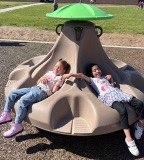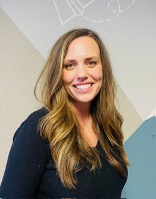For the 30 minutes of recess at Lakevue Elementary School in Nampa, Zach never stops swinging. Students take turns pushing him as he smiles and laughs.
Zach, who uses a wheelchair, used to spend recess sitting with a quiet activity. But that all changed when staff at Lakevue voted to spend surplus PTO money on a few items of inclusive playground equipment. Now he can play with his friends on the playground by being safely strapped into an accessible swing.
Thomas Watson, Executive Director of the Idaho Playground Project, had students in mind like Zach when he and his wife Jessi Watson started the Idaho Playground Project, a nonprofit organization aiming to build 100 inclusive playgrounds in Idaho by 2033.
“Every[one] understands the concept that no child should ever be left alone at recess,” Watson explained.

About 70% of Idaho elementary playgrounds currently don’t meet ADA accessibility guidelines, according to research done by the project. And roughly 6% of Idaho elementary school students (29,727) have limited access to playground facilities at their school due to a varied ability.
Watson’s goal of 100 playgrounds by 2033 needs major funds. An accessible playground costs anywhere between $250,000 to $500,000. This means by 2027, the Idaho Playground Project will need to be raising around $3 million dollars per year.

“I don’t think that people fully understand how important the playground and play is for development and learning,” said Idaho Playground Project Board Member Kim Leonard. “It’s not about building playgrounds, it’s about building relationships. It’s about building social skills and motor skills and all the skills in between… and seeing [those with disabilities] side by side with their peers is absolutely incredible.”
With an accessible playground, a wheelchair user might twirl around on a spinner with their friends, or play a large version of Connect 4 integrated into the playground equipment.
Other students who cannot safely climb could play with sensory activities like xylophones, drums or gears. Sidewalks to and from the school and rubber surfacing at the playground also allow wheelchair users to access the equipment.
When it comes to the students, the board members listed benefits of accessible playgrounds for not only the children with disabilities, but their friends as well. “They create inclusion just naturally without adults forcing it,” Board Member Kelly Vriesman explained.

Watson’s team came together due in large part to coincidence. When he approached elementary educator and long-time friend Vriesman with his idea for a non-profit, she replied, “Did you know my sister is currently doing exactly what you’re talking about in Twin Falls?”
In fact, Leonard had just finished coordinating a massive fundraising effort to build “Zella’s Playground” at Sawtooth Elementary School in Twin Falls. Her child was a friend of Zella’s and that spurred Leonard to get involved.
The sisters saw that their respective careers and experience came together to make them ideal collaborators for the Idaho Playground Project. Leonard has worked with children with developmental disabilities for 20 years. Vriesman had worked with students of all abilities as an elementary school teacher with 10 years experience.

The Idaho Playground Project will first focus on re-doing elementary school playgrounds, which community members can also use outside of school hours. They will prioritize schools furthest from any other ADA accessible public playgrounds.
Watson explained that relying on school district education budgets for new playgrounds is out of the question. “Leaders in school districts…will tell you, ‘we hardly have enough money to paint the hallway.’”
West Ada school district proposed a $500 million plant facilities levy last year which included $32 million for helping upgrade and increase accessibility of playgrounds. It did not pass.
The board members remain optimistic about finding financial partners who share their goals. “Every day we meet new people who are equally passionate about the idea of building accessible playgrounds around the state where schools lack the funding to do so themselves,” Watson said.
The team plans to get funds through partnering with corporations, applying for grants and holding fundraisers like their “trivia launch night” they held last month. Their first project will be to help Twin Falls School District finish out their playground plans by creating an accessible playground at Harrison Elementary school.

